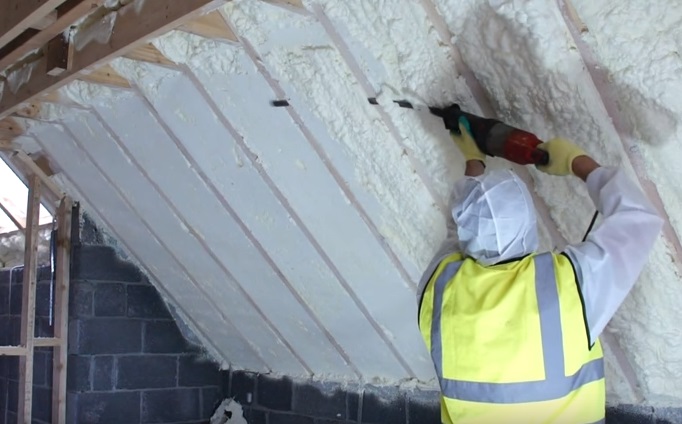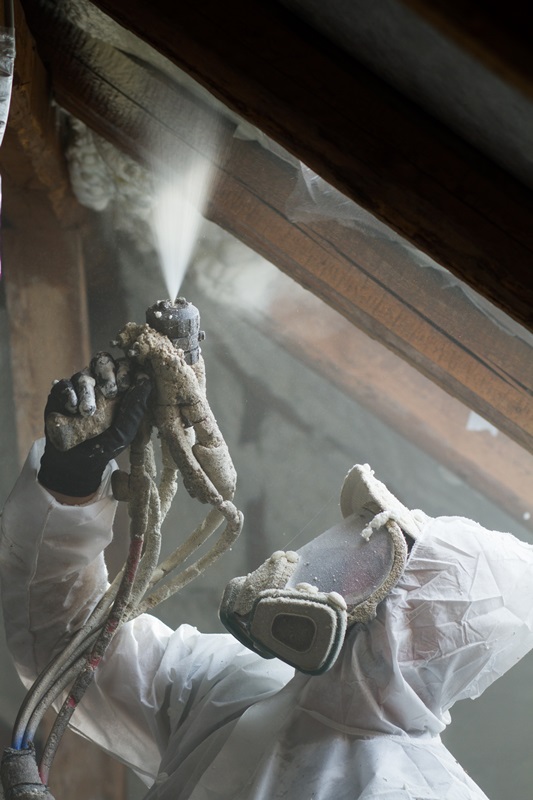Spray Foam Insulation Dallas
Spray Foam Insulation for Attics in Dallas and Fort Worth
Upgrade Your Insulation Now For Comfort and Efficiency
Spray Foam Attic Insulation Dallas
You can improve your house’s energy performance by upgrading your attic insulation system. Whether it is for new installations, retrofits, weatherization, or air sealing in vented or unvented attics, spray polyurethane foam is the best choice.
If you seal cracks and air spaces around your house, many of which are normally located in attics, you can save up to 20% on your monthly utility bills, according to the Energy Star program of the Environmental Protection Agency.
Along with squandering energy, a leaky attic drains your wallet also.
Experienced technicians at Spray Foam Pros can change old and substandard insulation with spray foam insulation. They can also upgrade your attic insulation system by sealing gaps around ductwork, studs, flues and components.
Home Owners in Fort Worth need attic insulation solutions that are tailored to meet their specific needs. Depending on your house’s needs, we can establish an attic insulation strategy for you.

Best Insulation For Attic In Dallas Texas
To insulate your attic space and shield your house from other weather and moisture related problems, spray foam insulation can be applied in 2 common ways– New Technology Building Science and Traditional Building Science
New Technology In Building Science
Insulation of Non-Ventilated Attics With Spray Foam:
The foam is sprayed directly onto the underside of the roof covering, between the joists, down around the rim, and into the soffit areas of the gable end walls, effectively sealing off the attic space and insulating it from any air infiltration. This application, considered the most effective in the SPF industry, completely seals the entire attic space from air leaks.
Normally, the undersides of roofs are not insulated in attics because “conventional” roofing and design methods call for attics to be ventilated in order to lower moisture problems and heat build-up throughout summer.
During the summer season, however, a vented attic in Dallas can very quickly turn into an oven with temperatures reaching 140 degrees. You should never have to run your air-conditioning and ductwork in such extreme conditions. In addition, condensation can form on these appliances. In Dallas, your attic is like a huge oven.
As a result of spraying spray foam straight on the underside of the roof deck, the attic is now insulated from the extreme heat that once radiated through the hot roof shingles and roof sheathing. Extreme temperatures are no longer experienced in the attic. By doing so, the attic now becomes an area of your home that is equally as comfortable as any other room in your home.
Traditional Building Science
For Vented Attics, Spray Foam Insulation Is Installed In The Attic Floor:
Your architect and/or home builder will likely prescribe the method for using spray foam in the attic based upon the building science and design concepts they follow. To insulate the ceiling from seasonal heat and/or cold, insulation is applied on the attic floor in a conventional vented attic. In places where fiberglass batts are used, such as between flooring joists, spray foam can be used instead. Most of the attic is uninsulated and very ventilated by gable, soffit, and ridge vents in the roofing system structure. Although most common throughout the United States, this sort of designed system might not be the most effective.
Contact Us Today To Schedule An Installation!
The benefits of spray foam insulation for your attic are numerous. Contact the professionals at Spray Foam Pros in Dallas, TX, if you are thinking about installing spray foam insulation in your attic.
Spray Foam Is Best Choice For Vented Attics
You may believe that you do not need to worry about leaks if your attic is vented and not part of the sealed thermal envelope of the building. There’s a likelihood that conditioned air is escaping from your living space because your attic is improperly sealed.
During the chilly months, warm air might leak unnoticed into your unconditioned attic from the joints at the attic top plate and around attic hatches left poorly finished by drywalling teams.
During the winter, many people understand just how unsafe it is to let heated air escape from your home. An improperly insulated attic can also raise your utility bills throughout the summer season in Dallas.
Depending on the temperature level outside, air accumulating under your roof covering might be even hotter than the air outside, so leaks like these between the living space of your house and its attic can be even worse! By filling these often-invisible voids, Spray Foam Pros can help keep your hard-earned dollars from leaking out of improperly sealed vented attics.
Spray Foam For Unvented (conditioned) Attics
Spray foam insulation is a great option if you’re building a new house, or if you want to transform your existing attic into living or storage space. Your attic conditioning system is dependent on it and it can result in substantial energy savings.
HVAC systems are commonly installed in attics to save space. The attic, if vented to the outdoors, are going to have all those ducts exposed to the outdoor temperature. For your house to remain comfortable, your HVAC system will have to work harder.
Installing spray polyurethane foam to your existing attic insulation will lower the load on your HVAC system and create more usable space in your house.
In finished attics, spray foam insulation is a superb choice for insulating behind knee walls and drop ceilings, yet it can also be used under the roof decking and between the roofing joists to integrate your attic with your house’s thermal envelope.
The use of spray foam in conditioned attics can enable you to lower your HVAC system’s size by up to 35%. If you do this before the first season, you can save hundreds or thousands of dollars.
Insulating your attic with spray polyurethane foam is an excellent choice in Dallas
Attics are the intersection of the interior and exterior of a house, a labyrinth of joints, angles, and seams. When you factor in the HVAC ducts, vents, and electric cables which run down into the living spaces and penetrate the building’s exterior sheathing, properly insulating an attic ends up being difficult.
In attics, spray foam is a perfect choice for filling the irregular seams around obstacles due to the fact that it expands up to thirty times the volume of its component liquids. Spray foam can be used to cover the joints around:
- Attic hatches
- Behind attic knee walls
- Wiring holes
- Plumbing vents
- Nail holes in roof decks
- Open exterior soffits
- Recessed lights, furnace flues or around HVAC ducts
A supplemental attic insulation installation is critical for year-round energy performance because heated air rises to the attic throughout the winter and receives the brunt of the sun throughout summers in Dallas.
Spray foam is one of the best insulators on the market, with an average R-value of 6.5. It also works as a moisture barrier beneath roofs, so it stops moisture from accumulating and causing mildew and mold to develop.

Do You Need A Price Quote Or Have Questions?
Do not let your cash fly out the window. Smart property owners are already saving on their energy costs month after month, every year. Which types of insulation installation and air sealing will make the most difference in your ongoing expenditures? Ask the insulation professionals!
GET A QUOTE
Answers to Common Attic Insulation Questions
Regardless of what sort of insulation you choose for your attic, it’s better than nothing. Attics in the majority of houses are usually insulated, but that insulation might be inadequate to make sure your house’s energy efficiency. It takes a lot of energy to keep your house comfortable, and one way to lower your energy usage is to upgrade your attic insulation. Attic and roof insulation can stop you from losing up to 20% of your conditioned air.
You can determine whether you have enough insulation by measuring the R-value, or the resistance to heat transfer. The R-value of 30 is commonly recommended by HVAC professionals and home builders, which means your attic needs to have at least 8.5 inches of insulation on the attic floor and insulation surrounding every one of your attic openings.
Your attic’s size, the material used, and how much is needed will determine the cost. Open cell foam insulation costs between $1 and $1.20 per square foot, and closed cell foam insulation costs between $1.25 and $1.50 per square foot
When it comes to installing insulation in their attics, the majority of property owners favor spray foam insulation to fiberglass insulation. Virtually 85% of all U.S. homes have fiberglass insulation. Although it’s cheaper to install, spray foam is usually more efficient, especially in extremely hot or cold environments. Spray foam insulation is usually airtight, while fiberglass insulation leaks air. The R-value of fiberglass is also lower than that of foam spray foam, at 2.2 per inch versus 3.5 per inch for open cell foam or 6 to 7 per inch for closed cell foam .
Although spray foam insulation costs more to install than traditional insulation types, it is often a lot more efficient in the long run. The energy savings associated with spray foam attic insulation range between 15% and 50%. There will also be an obvious difference in your house’s comfort levels. Correctly installed spray foam seals up spaces, allowing more conditioned air to enter your home. Additionally, your a/c unit or heater will run less often, while still maintaining your home at a comfortable temperature level.
Using open cell or closed cell insulation will determine the thickness of the spray foam insulation you use. The roof deck needs to be sprayed with 6 inches of open cell spray foam insulation. Closed cell foam needs to be sprayed about 4 to 5 inches thick on the roofing deck.
About Us
With a convenient location in Dallas Texas, Spray Foam Pros provides high quality spray foam to homeowners and businesses in Tarrant, Dallas, Denton, and Collin Counties. We can help you lower energy expenses, reinforce structures, and weatherproof your property. For more details on spray foam, please contact us at
Services
– Residential Spray Foam Insulation
– Commercial Spray Foam Insulation
– Crawl Space Spray Foam Insulation
– Closed-cell Spray Foam Insulation
– Open-cell Spray Foam Insulation
– Attic Insulation
– Insulation Removal & More
Business Hours
Monday 8AM–6PM
Tuesday 8AM–6PM
Wednesday 8AM–6PM
Thursday 8AM–6PM
Friday 8AM–6PM
Saturday 8AM–4PM
Sunday Closed
This site is a free service to assist homeowners in connecting with local service contractors. All contractors are independent and this site does not warrant or guarantee any work performed. It is the responsibility of the property owner to verify that the hired contractor furnishes the necessary license and insurance required for the work being performed.
